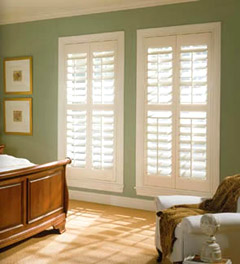What You Need To Know About St. Tammany Plantation Shutters

St. Tammany Plantation shutters are becoming a popular, effective way to add a new, elegant look to your home. They are both functional and attractive.
Parts of a St. Tammany plantation shutter
Traditional St. Tammany plantation shutters have a rather simple design. Plantation shutters normally are made up of a set of full-length vertical panels, and can be divided into four main parts:
The horizontal slats found on the top and bottom of the shutter are referred to as the ‘rails’. Some St. Tammany plantation shutters may also contain one or more horizontal rails in the center of the shutter, dividing the St. Tammany plantation shutter into separate tiers.
Located on the sides of the shutter, are vertical ‘stiles’.
‘Louvers’ are the parallel slats found between the stiles, which are able to be tilted and adjusted to allow in more or less light. Louvers can be made in a number of various sizes and shapes.
The ’tilt rod’ is the mechanism which controls the movement of the louvers. These also come in a variety of styles.
- Single tilt rods are one continuous, vertical rod connecting and controlling all the louvers simultaneously.
- A split tilt rod is exactly that: a tilt rod split into individual pieces. This allows separate control of several tiers found on one shutter panel, for example, adjusting the top tier to allow in more light, while keeping a lower tier’s louvers closed, for privacy.
- Hidden tilt rods allow the apparatus to be discreetly concealed behind the shutter panel.
Where did St. Tammany plantation shutters come from?
Shutters have been used for many, many centuries. Some experts claim that they were used as far back as ancient Greece, with slats being made from marble slabs. They were used before glass was available, to provide protection from the elements, such as rain, wind, and direct heat from the sun’s rays. They also effectively guarded against insects and small animals entering the building. The real function of the shutters was appreciated when these elements and pests passed, and the shutters could be opened, allowing for fresh sunlight and a cool breeze to ventilate the establishment.
Many old Southern homes found the beauty and practicality of these shutters, incorporating them into the design of the decadent mansions found on plantations in the Old South. The term St. Tammany ‘plantation shutter’ was derived from these applications. These shutters have seen remarkably few modifications since these early times.
Modern St. Tammany plantation shutters
Today, St. Tammany plantation shutters come in a vast array of sizes, styles, and materials. They can be found throughout the globe, in every style of home. Most are made of hardwoods such as poplar or bass and can a have a number of finishes to add architectural allure to residential and commercial properties. St. Tammany Plantation shutters made of rich woods such as cherry, oak, mahogany, or walnut are exceptionally attractive.
St. Tammany Plantation shutters can be used individually, or linked together to cover several windows, or one large one. Many manufacturers of St. Tammany plantation shutters allow you to have custom shutters built to your specifications to add a unique look to your home and make a design statement.
Today’s St. Tammany plantation shutters still offer the many practicalities that previous generations found so useful. St. Tammany Plantation shutters are fully adjustable to allow for more or less light, offer privacy, and can even have insulation benefits.












